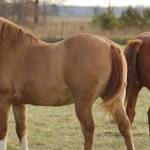Obese Horses Likely to Be More Dominant

According to a team of British researchers*, the more dominant a horse, the more likely it is to have a higher body condition score or struggle with obesity.
One interesting take-home message from this study: middle-aged horses were more likely to be dominant than younger and older horses. This finding was determined by observing 203 outdoor-living domestic horses in 42 separate herds in the United Kingdom during a feeding trial test. The test involved offering individual servings of hay or grain one horse length apart to all horses in the paddock at the same time and counting the number of “displacements” that occurred from the food. Dominance rank was then calculated based on those displacements (i.e., the number of times an individual was displaced from a feeder vs. the number of times it displaced another horse). Age, height, and body condition scores (BCS) of each horse were measured.
Key findings of the study were:
- Mean body condition score for horses in the study population was 5.53 on a scale of 1–9;
- 17.24% of horses were obese (BCS ≥7);
- A strong relationship between dominance and BCS was identified, meaning as dominance increased so did BCS;
- Similarly, as dominance increased, so did the rate of obesity. In fact, dominance rank was 11 times higher in obese than nonobese horses;
- Smaller horses (ponies) were more likely to be obese;
- Middle-aged horses were more likely to be dominant than younger and older horses; and
- Height had no impact on dominance.
“This study identified a high rate of obesity among outdoor-living horses as well as a higher dominance rank in obese horses. Considering the known negative relationship between obesity and health and the rising rate of nutrition-related disorders, a greater understanding of behavioral and social factors that influence body condition is needed,” notes Peter Huntington, B.V.Sc., M.A.C.V.Sc. director of nutrition, Kentucky Equine Research (Australia).
In the meantime, don’t feed any concentrates apart from low-intake vitamin and mineral supplements and try using grazing muzzles; removing overweight or obese horses from the herd for a few hours each day to decrease pasture intake; and exercising (e.g., longeing or riding) overweight horses to improve condition.
This study is interesting from a number of other points of view as well. First, this study shows that BCS rather than other factors such as height (as previously reported) impact dominance. Second, as pointed out by the study authors, dominance in horses is highly context-specific, meaning a horse that is dominant in a food-related context might not be dominant in terms of other resources such as shelter. Third, this study also found that herds with less variation in age and height had more interactions (e.g., kicking, biting, displacements). Housing horses of similar age and height is common in various situations. This finding suggests that when horses of variable ages and breeds are kept together in groups, they are more likely to associate and engage in friendly interactions.
For additional information and tips on managing BCS, see Winter Horse Care: Body Condition,Horse Weight Loss: Try These Six Steps, and Seasonal Variation in Horse Body Condition.
*Giles, S.L., C.J. Nicol, P.A. Harris, et al. 2015. Dominance rank is associated with body condition in outdoor-living domestic horses (Equus caballus). Applied Animal Behaviour Science 166:71–79.








